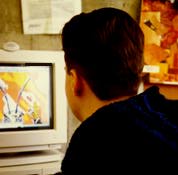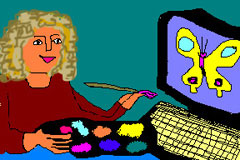


Introduction
I've been taking courses
online since 1994 and have been teaching teachers online since 1997.
I have observed many changes in the tools available. Browsers were
relatively new back then (first used in 1995) and Learning Management systems
(what few there were) (first used in 1997) were quite easy to navigate
for example, Web Course in a Box. Here for example is a paper on this subject
from 1998 - Reflections
re: OnLine Style Summer 98: a journey regarding communications online.
The more complex the software, systems and the upgrades, the more I look for creative projects to assign and hopefully students will find the projects can be adapted to a range of technical abilities for everyone in the class from newbie to techie. I aim to guide graduate students (Master of Teaching, Master of Education and PhD programs in the Department of Curriculum Teaching and Learning at OISE/UT) into experiences that will enhance their learning and will suggest ideas for how they can use similar projects in their own teaching.
The projects I assign are designed to be provocative, and to stimulate participants to learn to use whatever systems we have at hand whatever the technical challenges. They do this work more comfortably if the collaborative activities involved engage them in projects with creative and (ultimately) satisfying outcomes. The projects I am sharing with you are associated with the two online courses I currently teach: Foundations of Curriculum and Holistic Approaches to Information Technology.
Details for Creativity in Collaborative Projects for Learning Partners and Small Groups:


Partner Project 1: The
assignment:.
Partners read a teacher
memoir and create a power point presentation giving the essence of the
book along with at least two provocative class discussion questions based
on their presentation.
Teacher Memoir Presentation
The assignment is to choose one book from a list I have provided (or one of a similar type). These books are the true life adventures of teachers and I believe much can be gained from learning about their lives in the classroom. I am hoping this will be a nice balance for the very scholarly academic articles on curriculum that you'll be reading throughout the course.
In this activity, you and your learning partner, (first come first serve on the book selection) will correspond about this activity in BlackBoard where I will provide partner tools so you an exchange files or post messages to be seen only by you two and me. You will both read the same book (you'll need to set up a schedule and create a plan for working) and through the process of your collaboration create a presentation to the class encapsulating the story.
You may be as inventive as you like about this “presentation” using your imagination and any technical abilities you may have between you. If you are conversant with Power Point for example, you can create a slide show that can be posted for all to see. Or you might devise some other way to engage the rest of the class as a method to communicate the discoveries the two (or three) of you made through reading the book together. Be sure to include at least two questions for reflection based on your presentation that will inspire class discussion.
Examples:
1. Small Victories: The
Real World of a Teacher, Her Students, and Their High School by Samuel
G. Freedman - (a power point presentation)
http://astralsite.com/teach/SmallVictories/index.htm
2. Tuesdays with Morrie by
Mitch Albom - http://www.youtube.com/watch?v=3H3ldLeTgwE
These partners also gave
the following additional resources:
Other related videos of interest:
The end of Ted Koppel's special
with Morrie
http://www.youtube.com/watch?v=-_mxu8FzOEU
Mitch on what he hopes you
get from his book:
http://www.youtube.com/watch?v=yJs-MFUtsZ4
Partner Project 2: The assignment:
Partners Design a Course
(Constructivist Model)
Partners, design an online
or hybrid course following the constructivist model and answer questions
about their design.
"Designing Instruction
for Technology-Enhanced Learning" by Patricia L. Rogers (ed) Copyright
© 2002, Idea Group Publishing.
Here's the assignment
in full…. Participants read:
Chapter 7: Nothing but the Blues: A Case Study in the Use of Technology to Enrich a University Course by Tracy Chao and Bruce Stovel, University of Alberta, Canada
1. Step One
Read the chapter.
2. Step Two
Hold a chat session. Decide
on a course that you and your partner(s) might develop together. Create
an outline of the course. Using concepts learned in the reading, discuss
the development of the course and briefly answer the following questions
given with the chapter.
Questions for Further
Consideration
What are the advantages
and the draw backs of implementing constructivist principles in a course?
What are some foreseeable
problems if you were to follow the same principles in your course?
What are the benefits and
challenges in integrating technology into a conventional course in higher
education?
How can you ensure that
students have a valuable learning experience?
3. Step Three
Together, create an introduction
to your posting of this assignment – why you chose this course to design
and the context for such a course.
4. Step Four
Create a summary or conclusion
regarding this activity – what you and your partner(s) gained from the
process.
5. Step Five
Put this all together. 1.
Intro 2. Chat (log of the chat or summary of the chat) 3. Summary of the
activity.
6. Step Six
Post the completed “Design
a Course” assignment in one note in the Partners View
Please see Examples of how Learning Partnerships handled this assignment:
Example 1: Active
Citizenship - http://astralsite.com/teach/ActiveCitizenship.pdf
Example 2: Cooking-Photographycourse.doc
(Blended course - Cooking-Photography101.pdf)
Example 3: Math-Data-Managementcourse.doc
(blended course - Math-Data-Mgmt.pdf
plus Q&A))
Example 4: Memorycourse.doc
(blended course - MemoryCourse.pdf
plus
Q&A)

Team projects created are web-based educational resources and they are developed in a “fishbowl” discussion group where other teams who are also working on similar projects may observe and comment on their progress and the outcome of their project. The team projects involve using both synchronous and asynchronous communication tools. BlackBoard, WebKF and First Class are the learning management systems used for these courses. Teams meet, choose a topic/theme for their resource, create a criteria or rubric for the project and a timeline for presenting the project. Chats are arranged and chat logs are published in the groups discussion area. When the projects are completed and presented, a self-evaluation by the team is also submitted giving five positive outcomes from the project along with five ideas for future improvements or extensions of the project.
Examples:http://astralsite.com/1799/gallery.html#Team Projects - Summer 2008
Questions? drkarsten@astralsite.com
This presentation created
for TCC: April 14, 2009